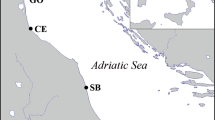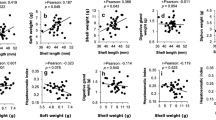Abstract
Growth performance of the Antarctic bivalve Laternula elliptica was examined both by shell microstructural observation and by applying a fluorescent substance, tetracycline, as a shell growth marker. The shell was composed of two calcareous layers: the thick outer layer was homogeneous or granular in structure and the thin inner layer was nacreous. The architecture of Antarctic L. elliptica was different from that of temperate L. marilina, and the ratio of thickness between the outer and inner layers appeared to be different. The growth rate of the nacreous layer was analyzed to be very low. High correlations were found between the major axis of chondrophore and both shell length and shell dry weight, respectively. It is suggested that the chondrophore is an appropriate growth indicator, and combining the information of growth increments with the fluorescent method may be useful in estimating the bivalve growth performance in the Antarctic sea.






Similar content being viewed by others
References
Ahn I-Y, Surh J, Park Y-G, Kwon H, Choi K-S, Kang S-H, Choi HJ, Kim K-W, Chung H (2003) Growth and seasonal energetics of the Antarctic bivalve Laternula elliptica from King George Island, Antarctica. Mar Ecol Prog Ser 257:99–110
Barrena E, Tevesz MJS, Carter JG, McCall PL (1994) Oxygen and carbon isotopic composition and shell microstructure of the bivalve Laternula elliptica from Antarctica. Palaios 9:275–287
Brey T, Clarke A (1993) Population dynamics of marine benthic invertebrates in Antarctic and subantarctic environments: are there unique adaptations? Antarct Sci 5:253–266
Brey T, Mackensen A (1997) Stable isotopes prove shell growth bands in the Antarctic bivalve Laternula elliptica to be formed annually. Polar Biol 17:465–468
Clarke A (1988) Seasonality in the Antarctic marine environment. Compar Biochem Physiol B 90:461–473
Clarke A (1996) Marine benthic populations in Antarctica: patterns and processes foundations for ecological research west of the Antarctic Peninsula. Ant Res Ser 70:373–388
Dayton PK (1989) Interdecadal variation in an Antarctic sponge and its predators from oceanographic climate shifts. Science 245:1484–1486
Dayton PK, Robilliard GA, Paine RT, Dayton LB (1974) Biological accommodation in the benthic community at McMurdo Sound Antarctica. Ecol Monogr 44:105–128
Fujikura K, Okoshi K, Naganuma T (2003) Strontium as a marker for estimation of microscopic growth rates in a bivalve. Mar Ecol Prog Ser 257:295–301
Hernaman V, Munday PL, Schlappy ML (2000) Validation of otolith growth-increment periodicity in tropical gobies. Mar Biol 137:715–726
Iglesias M, Brother EB, Morales-Nin B (1997) Validation of daily increment deposition in otoliths: age and growth determination of Aphia minuta (Pisces: Gobiidae) from the northwest Mediterranean. Mar Biol 129:279–287
Jones DS, Williams DF, Arthur MA (1983) Growth history and ecology of the Atlantic surf clam, Spisula solidissima (Dillwyn), as revealed by stable isotopes and annual shell increments. J Exp Mar Biol Ecol 73:225–242
Kaehler S, McQuaid CD (1999) Use of the fluorochrome calcein as an in situ growth marker in the brown mussel Perna perna. Mar Biol 133:455–460
Morton B (1973) The biology and function, morphology of Laternula truncate (Lamarck 1818) (Bivalvia: Anomalodesmata: Pandracea). Biol Bull 145:509–531
Newcombe CL (1936) Validity of concentric rings of Mya arenaria L for determining age. Nature 137:191–192
Nolan CP, Clarke A (1993) Growth in the bivalve Yoldia eightsi at Signy Island, Antarctica, determined from internal shell increments and calcium-45 incorporation. Mar Biol 117:243–250
Numanami H, Okutani T, Iwami T, Takeuchi I, Igarashi A, Tsuchiya Y, Fukuchi M (1996) A record of gastropods and bivalves collected from east Antarctica by the Japanese Antarctic Research Expeditions in 1992-94. Proc NIPRO Symp Polar Biol 9:207–223
Okoshi K (2000) Analyses of shell and pearl formation by fluorescent substances. In: Proceedings of the book of abstracts, international marine biotechnology conference 2000. Townsville, p 132
Okoshi K (2001) Kaigara Kainoha Gokainoha. Seizando-shoten, Tokyo, pp 164 (in Japanese)
Okoshi K (2003) Analyses of hard tissue formation by fluorescent substances in mollusks. In: Kobayashi I, Ozawa H (eds) Biomineralization formation, diversity, evolution and application. Tokai University Press, Kanagawa, pp 202–206
Okoshi K, Sato-Okoshi W (1996) Biomineralization in molluscan aquaculture growth and disease. Bull Inst Océanogr Monaco 14:151–169
Ralph R, Maxwell JGH (1977) Growth of two Antarctic Lamellibranchs: Adamussium colbeck i and Laternula elliptica. Mar Biol 42:171–175
Rauschert M (1991) Ergebrnisse der faunistischen Arbeiten im Benthal von King George Island (Sdshetlandinseln, Antarctis). Ber Polarforsch 76:1–75
Sato-Okoshi W, Okoshi K (2002) Application of fluorescent substance to the analysis of growth performance in Antarctic bivalve, Laternula elliptica. Polar Biosci 15:66–74
Sejr M, Sand MK, Jensen KT, Petersen JK, Christensen PB, Rysgaard S (2002) Growth and production of Hiatella arctica (Bivalvia) in a high-Arctic fjord (Young Sound, Northeast Greenland). Mar Ecol Prog Ser 244:163–169
Shabica SV (1976) The natural history of the Antarctic limpet Patinigera polaris (Hombron and Jacquinot). Ph.D. thesis, University of Oregon
Taylor JD, Kennedy WJ, Hall A (1973) The shell structure and mineralogy of the Bivalvia II Lucinacea-Clavagellacea, conclusions. Bull Br Mus Nat Hist Zool 22:255–294
Acknowledgments
We thank the members of the 42nd and the 45th Japanese Antarctic Research Expedition for their kind support in the conduct of this survey. Special thanks to Drs. S. Ban, T. Hirawake, S. Imura, S. Kudo, and Mr. W. Takahashi for their co-operation in collecting bivalves. We also extend our gratitude to Drs. A. Taniguchi and M. Fukuchi who supported the present study. Sincere thanks are given to Dr. J. Shaw and three anonymous referees for their critical reading the manuscript.
Author information
Authors and Affiliations
Corresponding author
Rights and permissions
About this article
Cite this article
Sato-Okoshi, W., Okoshi, K. Characteristics of shell microstructure and growth analysis of the Antarctic bivalve Laternula elliptica from Lützow-Holm Bay, Antarctica. Polar Biol 31, 131–138 (2008). https://doi.org/10.1007/s00300-007-0340-9
Received:
Revised:
Accepted:
Published:
Issue Date:
DOI: https://doi.org/10.1007/s00300-007-0340-9




